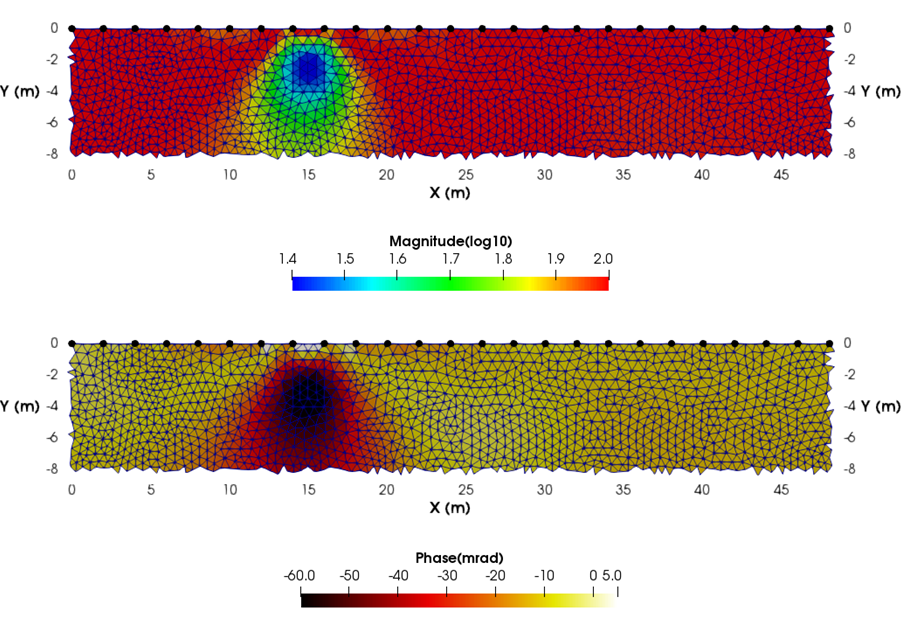cR2 version 3.0 April 2020
cR2 has been developed for imaging complex resistivity (i.e. induced polarization) using arbitrary electrode arrays on the ground surface or in boreholes. cR2 is based on R2, using complex numbers to represent conduction and polarization. cR2 will compute a forward model for a given distribution of complex resistivity (defined in terms of magnitude and phase angle). cR2 can also provide an inverse solution for a 2-D complex resistivity distribution based on computation of 3-D current flow using a finite element mesh based on either triangle or quadrilateral elements. The use of finite elements allows topography to be incorporated in the model. The inverse solution is based on a regularised objective function combined with weighted least squares (an 'Occams' type solution) as defined in Binley and Kemna (2005) and Binley (2015). A 64bit version for Intel compatible processors is provided in the download. Executables for other platforms are available from the author.The current version has no problem size limits.
cR2 also contains features allowing regularisation disconnect and zoning within the region of investigation.cR2 will output inverse models in x,y,z ASCII format suitable for plotting with third party software. cR2 also produces vtk formatted output allowing quick plotting with Paraview
In cR2 complex resistivity is defined by a magnitude and phase angle. The magnitude is equivalent to a DC resistivity since the phase angles are likely to be small. In an inversion, cR2 also computes the real and imaginary conductivity since these are more useful for analysis of the conduction and polarization of the subsurface. Data for cR2 are supplied in terms of magnitude and phase angle of the measured impedance.
It is strongly recommended that the user becomes familiar with inverting DC resistivity data with sister code R2 before working with cR2. Many of the concepts about meshing, parameterisation are similar.


Changes to cR2 from v2.0
General (unstructured) quadrilateral mesh input now an option. When an unstructured (triangular or quadrilateral) mesh is used the mesh.dat file now needs specification of the Dirichlet node in line 1. Error checking on presence of input files. Mesh error checks when mesh is read from file mesh.dat. Output of model roughness in main log file. Bug fix: geometric factor calculations for triangular meshes. Bug fix: output of electrode codes in the _err.dat file (only has impact if electrode numbers are different to the order they are defined in cR2.in.Download cR2
Note that there is no installation script to run. The cR2 executable should be copied to a working folder and run from there. Examples are provided (see download below).User guide (pdf)
Download cR2 program and guide ( .zip file)

ResIPy (formerly pyR2): NEW Python GUI for cR2 (and sister codes)
Guillaume Blanchy (formerly Lancaster), Sina Saneiyan (formerly Rutgers, now Oklahoma) and Jimmy Boyd (Lancaster) have developed ResIPy: a python GUI for cR2 and sister codes. The GUI is open source and standalone executables are available at the ResIPy gitlab site. More information is also available at the ResIPy ResearchGate site. See also Blanchy et al.(2020)References
Binley, A., 2015, Tools and Techniques: DC Electrical Methods, In: Treatise on Geophysics, 2nd Edition, G Schubert (Ed.), Elsevier., Vol. 11, 233-259, doi:10.1016/B978-0-444-53802-4.00192-5. (available from the author on request).Binley, A. and A. Kemna, 2005, Electrical Methods, In: Hydrogeophysics by Rubin and Hubbard (Eds.), 129-156, Springer
Blanchy, G., S. Saneiyan, J. Boyd, P. McLachlan and A. Binley, ResIPy, 2020, an intuitive open source software for complex geoelectrical inversion/modeling in 2D space, Computer & Geosciences, 137, doi:10.1016/j.cageo.2020.104423.
